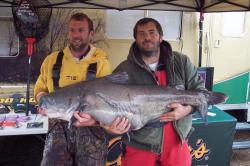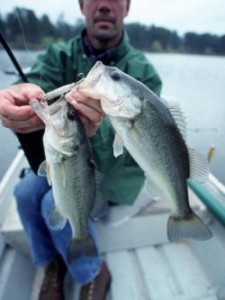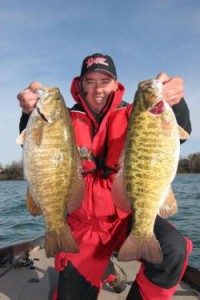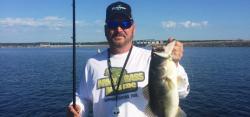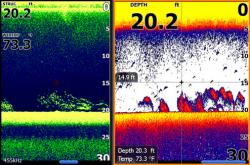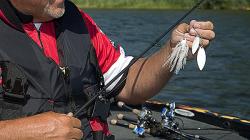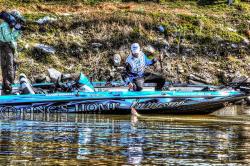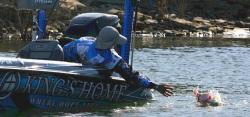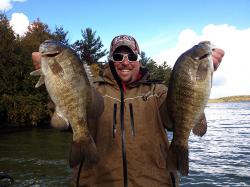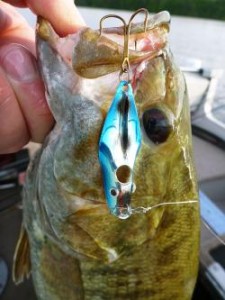We all yearn for a private lake where access is limited, the bass grow big and fat and there are no irritating pleasure boaters. That is a dream for almost all of us, but you can have most of those conditions at Lake Juliette. You can catch November bass at Lake Juliette.
Juliette is a 3000 acre Georgia Power Lake about 20 miles east of I-75 half-way between Atlanta and Macon. It is the cooling lake for Plant Scherer and built just for that purpose. It is on Rum Creek but the small flow from the creek does not keep it filled. Water is pumped from the Ocmulgee River to keep it full.
Fortunately, Georgia Power provides access to anglers and works with the Georgia Department of Natural Resources to manage the lake. The water is very clear since there is little inflow and natural cover from standing timber to huge grass beds is abundant.
There is good access to the lake from two boat ramps but there is a 25 horsepower limit on motors. You can put your bass boat in and fish, but you can not crank your gas motor. The size of the lake makes it difficult to fish it with just a trolling motor but if you have access to a smaller boat the fishing can be fantastic. And the horsepower limit means no skiers, jet skis and other pleasure boats on the lake.
Jack “Zero” Ridgeway has lived in Griffin all his life and owns Zero’s Garage there. He fishes with two local bass clubs, but Juliette is one of his favorite lakes. He has a boat with a legal motor for Juliette and fishes it a lot. For several years he entered the monthly bass tournament on Juliette and did well in them.
“Bass at Juliette don’t have to move as far as they do on bigger lakes in the fall migration,” Jack said. They do follow the shad into the creeks and coves, but the lake’s smaller size means it is easier to fish many creeks without burning a lot of gas.
Most baits will catch November bass on Juliette, but Jack’s favorites all work well for him and keep the number of rods you need manageable. He will have a rattling bait like a half-ounce XCalibur One Knocker, a rattling, suspending Shad Rap, a DT 6 or Norman Middle N crankbait, and a Carolina rigged worm ready to cover where he fishes. He may also throw a spinnerbait a little.
The lake has a lot of four to six pound bass, with a good chance of a bigger fish, too. While Jack and I fished his November holes to check them out the last Sunday in September, the last monthly tournament was taking place. At weigh-in it took five bass weighing 19.97 pounds to win and that stringer included two over six pounds. The top six teams all had over 16.5 pounds and there were six bass over five pounds.
Jack’s best bass on Juliette weighed over seven pounds and he has landed over 40 six pound plus bass there since he started fishing the lake in 1988. In one pot tournament he had five weighing just over 20 pounds, and came in second that day. He often camps at Juliette and fishes it every month of the year. November is one of his best months.
We fished the following ten spots and fish were on most of them, even in late September. More and bigger fish are on them now and they will get better all month long.
1. N 33 01.940 – W 83 47.027 – Going up the lake from the Dames Ferry Ramp, Davis Cove is a big creek on the left, just downstream of the long shallow island where the lake narrows. Go back into the cove to the first small cove on the left bank and start on the upstream point.
This point has some clay and rocks on it and bass live back in here year round, but more move into it in the fall. Fish crankbaits, rattle baits and a Carolina rig as you go from this point and the next one toward the back of the creek. Then jump across to the rocky point on the other side and fish it. The cove channel runs down this bank.
The rocky point on the right going in is the upstream side of a small feeder creek and has a blue pole with the number 8 on the bank. Fish it and the point on the other side of the creek, too. Jack says he has caught four bass over six pounds off the rocky point, one of them the day after Thanksgiving. We caught several bass here.
2. N 33 02.637 – W 83 47.041 – Out on the main lake go to the upstream side out on the end of the long, shallow point coming off the island where the lake narrows. This point and the pocket upstream of the island is covered with hydrilla and there is a patch of standing timber out in the middle of the cove. All hold bass.
Jack says more eight pound plus bass have been caught in this area than anywhere else on the lake. Start out on the end of the point and work toward the bank on the upstream side of the island. Stay on the outside of the hydrilla and cast a rattling bait to the edge of the visible grass, ripping it free when it hits underwater grass.
The half ounce silver and black One Knocker is Zero’s favorite bait for this area. He will also cast a suspending natural shad Shad Rap to the grass, ripping it free when it hits grass, too. We caught several keepers here and saw the tournament winners fishing the same way while we were there.
When you get to the back of the cove ease out to the timber and cast your Carolina rig around it. There is an old grave yard near the timber and bass hold around the trees and the holes where the graves were dug up for removal when the lake was built.
3. N 33 03.025 – W 83 47.768 – Across the lake in the last pocket on the right before you get to the intake cove for the power plant holds bass. Go back into the pocket and you will see an old beaver lodge on the bank. Near the lodge the bank is steep and a ditch runs along the bank. Jack says he thinks it is an old silage trench.
Start just outside the beaver lodge with your boat out a fairly long cast from the bank. Cast a Carolina rigged worm to the bank. Jack likes a three quarters ounce sinker, three foot leader and a ruby red or red shad Old Monster or Mag 2 worm. Work the rig from the bank down the slope. Fish slowly and carefully. Jack says bass often just suck in the worm and hold it without moving, so it is hard to tell if you have hit grass or have a fish on.
4. N 33 02.873 – W 83 49.876 – Go upstream past the power plant and the cove with the dam in it for the settling pond on the right. As you enter the standing timber be careful to follow the marked channel. There is an open field on the right. Across from it you will see a clay point. It is the point that sticks out the most on that side upstream of Billy’s Island.
Go to this point, being careful as you idle through the timber when you leave the channel.
This is the downstream point of a small cove with an old pond in the middle of it. There is standing timber all around the cove but the middle is open where the old pond was located. Stop on the point and fish back into and around the cove.
Fish a crankbait and rattle bait around this cove. For crankbaits, a chartreuse splatter back or sexy shad color works well. Jack fishes both kinds of baits on eight pound test line and makes fairly long casts from the middle of the cove toward the bank as he fishes around it.
Jack says this is an excellent cold weather cove and there were schooling fish here the day we fished. We caught several keepers and Jack had a five pounder that hit his One Knocker, jumped twice then got his line around the trolling motor and broke off.
5. N 33 02.382 – W 83 49.909 – Go back downstream to the next big cove on the same side. It is behind Billy’s island and called Fletcher Cove on the map. Stay to the left going back into it. This arm splits into three fingers in the back.
Stop on the point between the finger to the right and the one straight ahead and fish it with all your baits. Fish from the point down the right bank into the middle finger. The bank is steep and the clay and scattered rocks hold bass. Down this bank in a small indention there is an old beaver lodge that holds bass. Fish around it carefully with your crankbait and Carolina rig.
6. N 33 02.747 – W 83 48.877 – Go back out to the main lake and head downstream. Past the next big creek on the right the main lake point is called Treasure Point and is across from the cove at the power plant. Stop on the downstream side of this big round point where it goes into the next big creek.
There is timber off this point. Keep your boat near it in about ten feet of water and cast to the bank. There is some clay bottom and scattered rock. Upstream of the end of the point a blowdown is in the water. Fish from the end of the point past the blowdown.
Jack fishes a crankbait here. Some wind blowing on the point helps make fish move onto it to feed. Since there is no current in Juliette Jack says it fishes like a big pond, with wind making a difference. Try to bump the bottom from two to ten feet deep.
7. N 33 01.936 – W 83 47.916 – Go downstream past the big creek and around the point. The next creek is Fleming Cove. Go into it and keep to the right arm all the way to the back where this side splits into two small arms.
Stop on the point between the two arms. There is an old bridge in the back of the right arm. The point has rocks on it so fish it with crankbait and Carolina rig. Sit out in deep water a moderate cast off the bank and fish water from the bank to at least ten feet deep.
Fish down the right bank past the point and you will see another beaver lodge. The bank and beaver lodge hold bass. Jack likes to fish around the lodges with a crankbait and Carolina rig, and can usually catch bass on them.
8. N 33 03.146 – W 83 46.542 – Go across the lake to the left bank going downstream. There is a big three arm bay, named Buzzard Bay on the map, just downstream of the power plant. Downstream of the bay two small islands sit off the bank back in the next big cove. There is lots of grass all around them.
The back island has a saddle between it and the point on the bank. There are rocks on the point and grass in the saddle. Start on the end of the island toward the bank and fish from it across the saddle to the bank point.
Jack fishes a crankbait and Carolina rig in this area, and will throw a spinnerbait around the grass in the saddle. He usually keeps his boat on the downstream side of the saddle and fishes across the points and saddle in that direction.
9. N 33 02.852 – W 83 46.413 – The next cove downstream of the islands splits into two arms and both them split, too. The downstream point of this cove is called Quail Head because of its shape. The point sticking out pointing toward the power plant is a good rocky point.
Fish your crankbaits around the rocks on the point, keeping your boat in 20 plus feet of water, not too far off the bank. Also cast a spinnerbait around the scattered grass on this point. Wind helps lot here.
10. N 33 02.542 – W 83 46.173 – Go around Quail Head point to the downstream side. There is a shallow hump off the bank on the downstream side and behind it a point sticks out toward the dam. Stop out in ten feet of water off this point.
Fish the point with crankbait and rattlebait then work into the pocket on the downstream side. The left bank going into the pocket is good. There is 30 feet of water not far off this point and bank and Jack says sometime during the day fish will move into the shallows to feed, so it is worth hitting several times during the day.
Give these spots a try, they are some of Jack’s favorites. There are many others in the lake and this is good time to fish there. Enjoy the peace and quiet and catch some quality bass.
